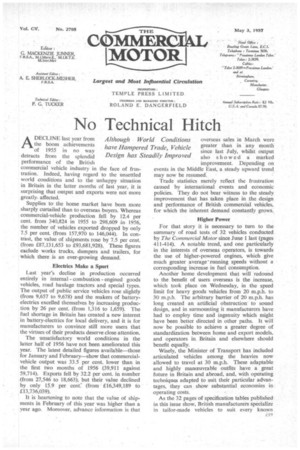No Technical Hitch
Page 65

Page 66

If you've noticed an error in this article please click here to report it so we can fix it.
ADECLINE last year from the boom achievements of 1955 in no way detracts from the splendid performance of the British commercial vehicle industry in the face of frustration. Indeed, having regard to the unsettled world conditions and to the unhappy situation in Britain in the latter months of last year, it is surprising that output and exports were not more greatly, affected.
Supplies to the home market have been more sharply curtailed than to overseas buyers. Whereas commercial-vehicle production fell by 12.4 per cent. from 340,824 in 1955 to 298,609 in 1956, the number of vehicles exported dropped by only 7.5 per cent. (from 157.970 to 14.6,044). In contrast, the value of shipments rose by 7.5 per cent. (from £87,131,653 to £93,681,928). These figures exclude works trucks, dumpers and trailers, for which there is an ever-growing demand.
Eleetrics Make a Spurt Last year's decline in production occurred entirely in internal combustion engined goods vehicles, road haulage tractors and special types. The output of public service vehicles rose slightly (from 9,657 to 9,678) and the makers of batteryelectrics excelled themselves by increasing production by 26 per cent. (from 1,316 to 1,659). The fuel shortage in Britain has created a new interest in battery-electrics for local delivery, and it is for manufacturers to convince still more users that the virtues of their products deserve close attention.
The unsatisfactory world conditions in the latter half of 1956 have not been ameliorated this year. The latest detailed figures available—those for January and February—show that commercialvehicle output was 33.5 per cent. lower than in the first two months of 1956 (39,911 against 59,714). Exports fell by 32.2 per cent. in number (from 27,546 to 18,663), but their value declined by only 15.9 per cent: (from £16,349,189 to £13,736,039).
It is heartening to note that the value of shipments in February of this year was higher than a year ago. Moreover, advance information is that overseas sales in March were greater than in any month since last July, whilst output also showed a marked improvement. Depending on events in the Middle East, a steady upward trend may now be resumed.
Trade statistics merely reflect the frustration caused by international events and economic policies. They do not bear witness to the steady improvement that has taken place in the design and performance of British commercial vehicles, for which the inherent demand constantly grows.
Higher Power For that story it is necessary to turn to the summary of road tests of 32 vehicles conducted by The Commercial Motor since June 1 last (pages 411-414). A notable trend, and one particularly in the interests of overseas operators, is towards the use of higher-powered engines, which give much greater average" running speeds without a corresponding increase in fuel consumption.
Another home development that will redound to the benefit of users overseas is the increase, which took place on Wednesday, in the speed limit for heavy goods vehicles from 20 m.p.h. to 30 m.p.h. The arbitrary barrier of 20 m.p.h. has long created an artificial obstruction to sound design, and in surmounting it manufacturers have had to employ time and ingenuity which might have been better directed in other paths. It will now be possible to achieve a greater degree of standardization between home and export models, and operators in Britain and elsewhere should benefit equally. Wisely, the Minister of Transport has included articulated vehicles among the heavies now allowed to travel at 30 m.p.h. These adaptable and highly manceuvrable outfits have a great future in Britain and abroad, and, with operating technique adapted to suit their particular advantages, they can show substantial economies in operating costs. As the 32 pages of specification tables published in this issue show, British manufacturers specialize in tailor-made vehicles to suit every known condition of operation. The standard range is extremely wide, but most makers are always willing to incorporate modifications to suit the exceptional requirements of customers. Last year the peak of achievement was temporarily flattened, but the industry has the capacity, skill and determination to meet its competitors on more than equal terms anywhere.












































































































































































































































